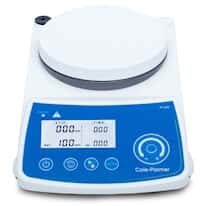Mixers & Stirrers
Magnetic Stirrer Repair and Calibration Procedures
November 7, 2024
Technical Team
Technical Guide

Article Summary
Comprehensive guide for maintaining Cole-Parmer magnetic stirrers including speed calibration, motor repair, and platform maintenance.
# Magnetic Stirrer Repair and Calibration Procedures
## Technical Overview and Specifications
Cole-Parmer magnetic stirrers, including the ST-300 Digital and ST-200 series, utilize precision-controlled magnetic drive systems for reliable sample mixing. Key specifications include:
- **Speed Range**: 100-1500 RPM continuously variable
- **Platform Material**: Chemical-resistant ceramic or PTFE coating
- **Motor Type**: Brushless DC with electronic speed control
- **Temperature Rating**: Platform rated to 350°C (stirring hot plates)
- **Magnetic Coupling**: Rare earth permanent magnets
- **Control Accuracy**: ±1% of set point for digital models
## Safety Warnings and Precautions
⚠️ **ELECTRICAL SAFETY**
- Disconnect power before any maintenance procedures
- Never immerse unit in water or cleaning solvents
- Inspect power cord for damage before each use
- Use GFCI protection in wet laboratory environments
⚠️ **MAGNETIC HAZARDS**
- Strong magnetic fields can affect pacemakers and electronic devices
- Keep credit cards and magnetic media away from unit
- Use caution when handling stir bars near the platform
- Magnetic field extends 6 inches from platform surface
⚠️ **CHEMICAL COMPATIBILITY**
- Verify chemical compatibility with platform materials
- Clean spills immediately to prevent platform damage
- Never use abrasive cleaners on ceramic surfaces
- Ensure adequate ventilation when stirring volatile chemicals
## Common Failure Modes and Diagnostic Procedures
### 1. Stir Bar Decoupling
**Symptoms:**
- Stir bar stops rotating or rotates erratically
- Inconsistent stirring speed despite constant settings
- Stir bar "dancing" or jumping in solution
**Diagnostic Steps:**
1. Test with known good stir bar of appropriate size
2. Check for magnetic debris on platform surface
3. Verify proper stir bar size for vessel (should be 2/3 vessel diameter)
4. Test magnetic field strength with gaussmeter (should be 800-1200 Gauss at platform surface)
### 2. Speed Control Issues
**Symptoms:**
- Unable to achieve low speeds (below 200 RPM)
- Speed fluctuations during operation
- Digital display shows incorrect RPM readings
**Diagnostic Steps:**
1. Calibrate tachometer feedback using optical sensor
2. Test speed control potentiometer for smooth resistance variation
3. Check PWM output signal with oscilloscope (should be clean 20kHz signal)
4. Verify encoder signals for digital models (A/B phase quadrature)
## Detailed Step-by-Step Repair Procedures
### Speed Calibration Procedure
**Required Tools:** Optical tachometer, stroboscope, precision stir bars
**Method 1: Optical Tachometer Calibration**
1. **Setup Preparation**
- Place unit on stable, vibration-free surface
- Install standard 25mm stir bar with reflective tape marker
- Fill 250ml beaker with distilled water
2. **Baseline Measurement**
- Set stirrer to minimum speed (100 RPM nominal)
- Allow 2-minute stabilization period
- Measure actual speed with optical tachometer (10 readings average)
- Record deviation from displayed value
3. **Multi-point Calibration**
- Test at 200, 500, 800, 1200, and 1500 RPM set points
- Document actual vs. displayed values
- Calculate linear regression for correction factors
4. **Adjustment Procedure (Digital Models)**
- Access calibration mode (typically hold SET + START buttons)
- Enter correction factors for each calibration point
- Save calibration data to non-volatile memory
- Verify calibration by repeating measurement sequence
### Platform Replacement and Alignment
**Required Tools:** Torx screwdrivers, platform alignment gauge, non-magnetic spacers
1. **Platform Removal**
- Disconnect power and allow complete cool-down
- Remove platform retaining screws (typically 4 Torx T-20)
- Lift platform straight up to avoid magnet contact
- Clean mounting surface with isopropyl alcohol
2. **Magnet Assembly Inspection**
- Check magnet array for chips or cracks
- Verify even spacing between magnetic pole pieces
- Test magnetic field uniformity across platform area
- Replace magnetic assembly if field variance exceeds 10%
3. **New Platform Installation**
- Verify platform material compatibility with application
- Check platform flatness (should be within 0.002" across surface)
- Align platform using manufacturer's gauge tool
- Install with proper torque sequence (5-7 ft-lbs, star pattern)
4. **Performance Verification**
- Test with standard stir bar and water solution
- Verify smooth operation at all speed settings
- Check for any noise or vibration anomalies
- Measure magnetic field strength at multiple points
## Calibration Procedures and Standards
### Annual Calibration Requirements
**Reference Standards Needed:**
- NIST-traceable optical tachometer (±0.1% accuracy)
- Precision timer for long-term stability testing
- Magnetic field gaussmeter for field strength verification
- Temperature-compensated test solutions
**Calibration Protocol:**
1. **Environmental Conditions**
- Temperature: 20°C ±2°C
- Humidity: 45-65% RH
- Stable electrical supply (±1% voltage variation)
- Vibration-free test surface
2. **Speed Accuracy Verification**
- Test minimum 5 points across operating range
- Hold each setting for 10 minutes before measurement
- Record 10 measurements per set point
- Calculate statistical uncertainty (±2σ)
- Accuracy requirement: ±2% of reading or ±5 RPM, whichever is greater
## Professional Service Recommendations
**When to Contact Factory Service:**
- Electronic control board failures requiring component-level repair
- Magnetic assembly replacement or remagnetization
- Precision machining of platform mounting surfaces
- Warranty repairs requiring factory authorization
**Preventive Maintenance Schedule:**
- **Daily**: Visual inspection and cleaning of platform surface
- **Weekly**: Check for loose hardware and proper grounding
- **Monthly**: Test operation at multiple speed settings
- **Quarterly**: Clean internal components and check connections
- **Annually**: Complete calibration and performance verification
Service documentation should include detailed records of operating hours, calibration results, repair history, and environmental conditions for optimal equipment longevity and performance tracking.
Need Additional Support?
If you're experiencing issues not covered in this guide, our technical team is here to help.
Contact Technical Support